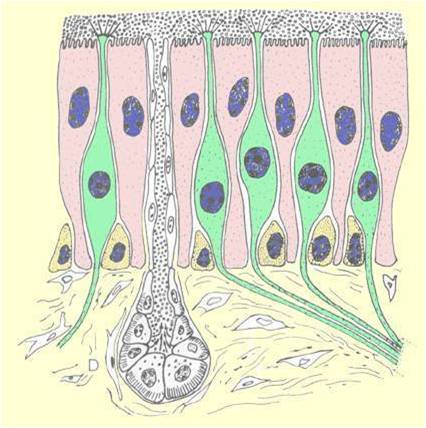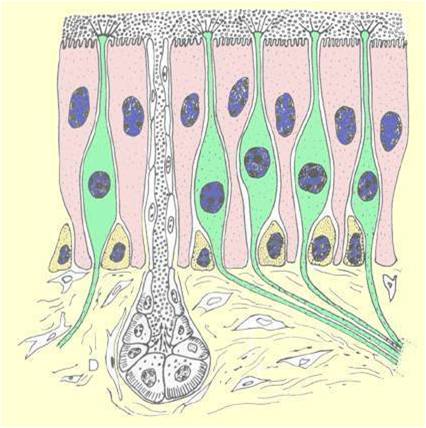Olfaction And Gustatation (Msq Drill 269)

http://www. Medicalschoolquizzes. Com by DrKash
- 1.
The following are all examples of_______________: i.e. taste, smell, carotid body receptors and osmoreceptors
- A.
Baroreceptors
- B.
Chemoreceptors
- C.
Negative feedback loops
- D.
Positive feedback loops
Correct Answer
B. Chemoreceptors -
- 2.
In a sensory pathway, what transduces the stimulus?
- A.
Sensory receptor
- B.
Intergrator
- C.
Afferent sensory neuron
- D.
CNS
Correct Answer
A. Sensory receptor -
- 3.
Sustained stimulation will lead to ____________ .
- A.
Turining off of the stimulus
- B.
Adaptation
- C.
Maladaptation
- D.
Heightening of the stimulus
Correct Answer
B. Adaptation -
- 4.
Which of the following either DO NOT adapt or adapt slowly?
- A.
Tonic receptors
- B.
Phasic receptors
Correct Answer
A. Tonic receptorsExplanation
Phasic receptors adapt rapidly.Rate this question:
-
- 5.
Which receptors continually transmit signals for the duration of the stimulus?
- A.
Tonic
- B.
Phasic
Correct Answer
A. TonicExplanation
Phasic receptors will cease firing if the strength of a continuous stimulant remains constantRate this question:
-
- 6.
What receptors allow the body to ignore constant uninmportant information?
- A.
Phasic
- B.
Tonic
Correct Answer
A. pHasicExplanation
With tonic receptors the parameters must constantly be monitored.Rate this question:
-
- 7.
Muscle stretch receptors and joint proprioreceptors are examples of tonic or phasic receptor types?
- A.
Tonic
- B.
Phasic
Correct Answer
A. TonicExplanation
This is because of the need to constantly update the CNS on the muscle length and joint position.Rate this question:
-
- 8.
Taste and smell send messages to phylogenetically old areas of the brain that are associated with? Check al that apply.
- A.
Pain
- B.
Memory
- C.
Emotion
- D.
Self defense
- E.
Salivation
Correct Answer(s)
B. Memory
C. Emotion -
- 9.
Is smell directional or non-directional?
- A.
Directional
- B.
Non-directional
Correct Answer
A. Directional -
- 10.
Which of the follwing basic tastes is associated with glutamate?
- A.
Sweet
- B.
Sour
- C.
Bitter
- D.
Salty
- E.
Umani
Correct Answer
E. Umani -
- 11.
Salt and sour taste senses are associated with:
- A.
Homeostasis
- B.
Calories
- C.
Toxins
- D.
Water intake
Correct Answer
A. Homeostasis -
- 12.
Are some taste preferences inborn?
- A.
Yes
- B.
No
Correct Answer
A. YesExplanation
eg preference for sweet tastes for mother's milk and the aversion to bitter tastes for avoiding toxins. Experience can nevertheless modify taste preferences.Rate this question:
-
- 13.
Does the body have the capacity to induce a preference for certain tastes due to deficiencies present?
- A.
Yes
- B.
No
Correct Answer
A. Yes -
- 14.
How many types of papillae on the tongue have taste buds?
- A.
1
- B.
2
- C.
3
- D.
4
- E.
5
Correct Answer
C. 3 -
- 15.
What is contained in a taste bud? check all that apply.
- A.
Receptor
- B.
Salivary ducts
- C.
Ridges
- D.
Supporting cells
Correct Answer(s)
A. Receptor
D. Supporting cells -
- 16.
What type of taste bud containing papillae are found at the most anterior part of the tongue, have one or more taste buds each and appear as cheryy red spots.
- A.
Filliform
- B.
Fungiform
- C.
Foliate
- D.
Circumvallate
Correct Answer
B. Fungiform -
- 17.
What papillae are found anterior to the fungiforms along the edge of the tongue and contain multiple taste buds?
- A.
Filliform
- B.
Foliate
- C.
Circumvellate
Correct Answer
B. Foliate -
- 18.
The circumvallate papilla are found
- A.
In the lateral portion of the tongue
- B.
In the back of the tongue
- C.
In the most lateral portion of the tongue
- D.
In the most anterior portion of the tongue
Correct Answer
B. In the back of the tongue -
- 19.
Do the esophagus, larynx and pharynx have taste buds?
- A.
Yes
- B.
No
Correct Answer
A. YesExplanation
as well as the soft palate.Rate this question:
-
- 20.
Taste receptors are clustered into organelles called
- A.
Organs
- B.
Aggregates
- C.
Papillae
- D.
Taste buds
Correct Answer
D. Taste buds -
- 21.
Most revceptor/chanels are located on the _______________ which are located on receptor cells.
- A.
Microvilli
- B.
Furrows
- C.
Ridges
- D.
Clefts
Correct Answer
A. Microvilli -
- 22.
New taste receptor cells differentiate from which types of cells?
- A.
Glial cells
- B.
Basal cells
- C.
Luminal cells
- D.
Sensory cells
Correct Answer
B. Basal cells -
- 23.
Taste receptor cells are continually replaced, every 10 to 14 days. Does this require any input from the sensory cells?
- A.
Yes
- B.
No
Correct Answer
A. Yes -
- 24.
Each taste bud contains: Check all that apply.
- A.
Sensory cells
- B.
Basal cells
- C.
Receptor cells
- D.
Microville
Correct Answer(s)
A. Sensory cells
B. Basal cells
C. Receptor cells
D. Microville -
- 25.
Are the sensory cells in the taste bud efferent or afferent?
- A.
Afferent
- B.
Efferent
Correct Answer
A. AfferentExplanation
These cells send the signal back to the CNS.Rate this question:
-
- 26.
The oropharynx and epiglottis are innervated by cranial nerve
- A.
7
- B.
9
- C.
10
- D.
6
Correct Answer
C. 10 -
- 27.
The posterior one third of the tongue is innervated by which cranial nerve?
- A.
7
- B.
9
- C.
10
- D.
11
- E.
12
Correct Answer
B. 9 -
- 28.
The anterior one third of the tongue is innervated by which cranial nerve?
- A.
7
- B.
9
- C.
10
- D.
12
Correct Answer
A. 7Explanation
via chorda tympaniRate this question:
-
- 29.
When considering how taste is perceived the taste stimuli interacts with channels or receptors that are located in the __________ .
- A.
Cleft
- B.
Ridge
- C.
Furrow
- D.
Microvilli
Correct Answer
D. Microvilli -
- 30.
When the taste sense binds to a receptor the cell will
- A.
Depolarize
- B.
Hyperpolarize
Correct Answer
A. Depolarize -
- 31.
When the cell depolarizes in response to a taste receptor binding what second messenger is released?
- A.
Pottasium
- B.
Sodium
- C.
Calcium
- D.
Chloride
Correct Answer
C. Calcium -
- 32.
Do all tastes result in increased calcium in the cell and subsequent release of the neurotransmiter?
- A.
Yes
- B.
No
Correct Answer
A. YesExplanation
the fundamental system is the same for all the different types of taste. After calcium is released, calcium concentration increases, neurotransmitter is released and a signal is relayed to the CNS.Rate this question:
-
- 33.
What are the mechanisms of taste transduction? Check all that apply.
- A.
Direct passage of a chemical through an ion channel (Na+, Ca2+, H+, K+).
- B.
Bind to and blocking ion channels.
- C.
Bind to and opening ion channels.
- D.
Bind to a membrane receptor and activates secondary messenger systems that in turn open or close ion channels (membrane receptors and G-proteins).
Correct Answer(s)
A. Direct passage of a chemical through an ion channel (Na+, Ca2+, H+, K+).
B. Bind to and blocking ion channels.
C. Bind to and opening ion channels.
D. Bind to a membrane receptor and activates secondary messenger systems that in turn open or close ion channels (membrane receptors and G-proteins). -
- 34.
When a patient has anosmia, they have lost their sense of
- A.
Taste
- B.
Smell
- C.
Touch
- D.
Vision
Correct Answer
B. SmellExplanation
It is usually due to a disease of the olfactory nervesRate this question:
-
- 35.
Can olfaction problems lead to problems with taste?
- A.
Yes
- B.
No
Correct Answer
A. Yes -
- 36.
The first order neuron coming from the taste buds synapses on neurons located in the:-
- A.
Nucleus solitarious
- B.
Inferior salivatory nucleus
- C.
Superior salivatory nucleus
- D.
VPM
- E.
The third order neuron
Correct Answer
A. Nucleus solitariousExplanation
There are three neurons in the pathway before the signal arrives in the cortex.Rate this question:
-
- 37.
What is the cortex where the perception of taste becomes conscious? Check al that apply.
- A.
Primary salivatory cortex
- B.
Primary gustatory cortex
- C.
Insula
- D.
Primary motor nucleus
Correct Answer(s)
B. Primary gustatory cortex
C. InsulaExplanation
The insula is part of the primary gustatory complex.Rate this question:
-
- 38.
The primary gustatory area is near the sensory area for the
- A.
Thorax
- B.
Leg
- C.
Ear
- D.
Tongue
Correct Answer
D. TongueExplanation
It extends down into the insula. The insula is also part of the gustatory center.Rate this question:
-
- 39.
The olfactory nerves are
- A.
Unipolar
- B.
Bipolar
- C.
Multipolar
- D.
Pseudounipolar
Correct Answer
B. Bipolar -
- 40.
What cells are responsible for producing new olfactory receptor cells?
- A.
Supporting cells
- B.
Glial cells
- C.
Basal cells
- D.
Astrocytes
Correct Answer
C. Basal cells -
- 41.
What are the green colored cells? This section is from the nasal epithelium.
- A.
Olfactory cell
- B.
Basal cell
- C.
Bowman's cell
- D.
Supporting cells
Correct Answer
A. Olfactory cell -
- 42.
What are the yellow colored cells?
- A.
Basal cells
- B.
Supporting cells
- C.
Bowman's cells
- D.
Cortical cells
Correct Answer
A. Basal cells -
- 43.
The gland in this picture is known as the:-
- A.
Olfactory gland
- B.
Bowman's gland
- C.
Vestibular gland
- D.
Gustatory gland
Correct Answer
B. Bowman's gland -
- 44.
In olfactory trasnduction, the G protein coupled receptors are related to
- A.
Taste transmembrane domains
- B.
Tactile opsins
- C.
Visual opsins
- D.
Hearing opsins
Correct Answer
C. Visual opsins -
- 45.
Are IP3 and cGMP involved in olfactory transdcution as well?
- A.
Yes
- B.
No
Correct Answer
A. Yes -
- 46.
Are the receptor cells in the olfactory system derivatives of neuropeithelial cells?
- A.
Yes
- B.
No
Correct Answer
B. NoExplanation
They are actual nerves in and of themselves.Rate this question:
-
- 47.
Do olfactory neurons regenerate?
- A.
Yes
- B.
No
Correct Answer
A. YesExplanation
They regenerate about every month.Rate this question:
-
- 48.
Which part of the olfactory system has the receptors for odorants?
- A.
Dendrites
- B.
Axons
- C.
Cillia
- D.
The soma
- E.
Microvilli
Correct Answer
C. Cillia -
- 49.
So depolarization occurs at the cilial cell, cAMP is generated via second messenger system, calcium influxes and _________ effluxes resulting in depolarization.
- A.
Sodium
- B.
Pottasium
- C.
Chloride
- D.
Magnesium
Correct Answer
C. Chloride -
- 50.
The olfactory cell synapses with both the peri glomerular cell and _______ .
- A.
Mitral cell
- B.
Granule cell
- C.
Centrifugal cell
Correct Answer
A. Mitral cellExplanation
The mitral cell will synapse with a granule cellRate this question:
-
Quiz Review Timeline +
Our quizzes are rigorously reviewed, monitored and continuously updated by our expert board to maintain accuracy, relevance, and timeliness.
-
Current Version
-
Jul 11, 2022Quiz Edited by
ProProfs Editorial Team -
Feb 21, 2010Quiz Created by
 Back to top
Back to top



